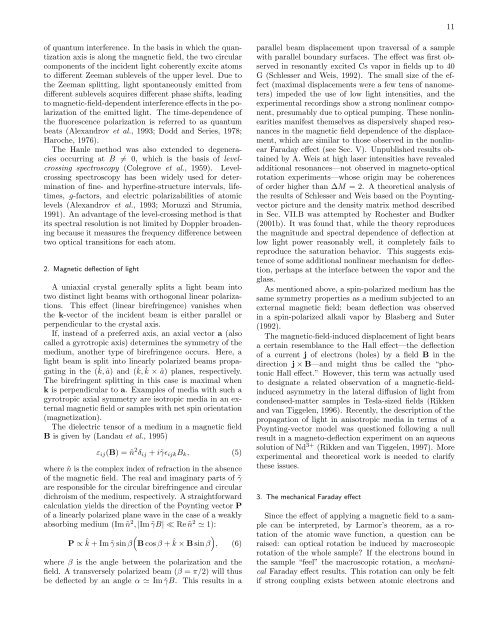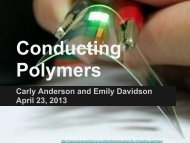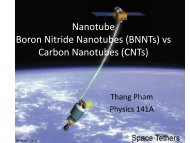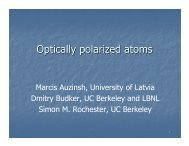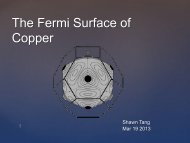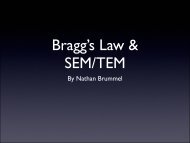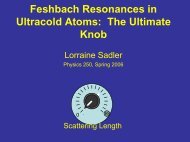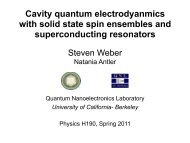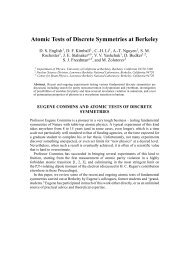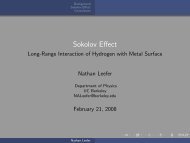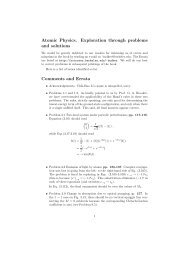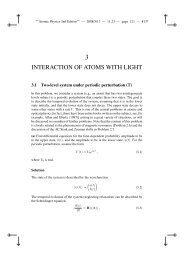Resonant nonlinear magneto-optical effects in atomsâ - The Budker ...
Resonant nonlinear magneto-optical effects in atomsâ - The Budker ...
Resonant nonlinear magneto-optical effects in atomsâ - The Budker ...
You also want an ePaper? Increase the reach of your titles
YUMPU automatically turns print PDFs into web optimized ePapers that Google loves.
11<br />
of quantum <strong>in</strong>terference. In the basis <strong>in</strong> which the quantization<br />
axis is along the magnetic field, the two circular<br />
components of the <strong>in</strong>cident light coherently excite atoms<br />
to different Zeeman sublevels of the upper level. Due to<br />
the Zeeman splitt<strong>in</strong>g, light spontaneously emitted from<br />
different sublevels acquires different phase shifts, lead<strong>in</strong>g<br />
to magnetic-field-dependent <strong>in</strong>terference <strong>effects</strong> <strong>in</strong> the polarization<br />
of the emitted light. <strong>The</strong> time-dependence of<br />
the fluorescence polarization is referred to as quantum<br />
beats (Alexandrov et al., 1993; Dodd and Series, 1978;<br />
Haroche, 1976).<br />
<strong>The</strong> Hanle method was also extended to degeneracies<br />
occurr<strong>in</strong>g at B ≠ 0, which is the basis of levelcross<strong>in</strong>g<br />
spectroscopy (Colegrove et al., 1959). Levelcross<strong>in</strong>g<br />
spectroscopy has been widely used for determ<strong>in</strong>ation<br />
of f<strong>in</strong>e- and hyperf<strong>in</strong>e-structure <strong>in</strong>tervals, lifetimes,<br />
g-factors, and electric polarizabilities of atomic<br />
levels (Alexandrov et al., 1993; Moruzzi and Strumia,<br />
1991). An advantage of the level-cross<strong>in</strong>g method is that<br />
its spectral resolution is not limited by Doppler broaden<strong>in</strong>g<br />
because it measures the frequency difference between<br />
two <strong>optical</strong> transitions for each atom.<br />
2. Magnetic deflection of light<br />
A uniaxial crystal generally splits a light beam <strong>in</strong>to<br />
two dist<strong>in</strong>ct light beams with orthogonal l<strong>in</strong>ear polarizations.<br />
This effect (l<strong>in</strong>ear birefr<strong>in</strong>gence) vanishes when<br />
the k-vector of the <strong>in</strong>cident beam is either parallel or<br />
perpendicular to the crystal axis.<br />
If, <strong>in</strong>stead of a preferred axis, an axial vector a (also<br />
called a gyrotropic axis) determ<strong>in</strong>es the symmetry of the<br />
medium, another type of birefr<strong>in</strong>gence occurs. Here, a<br />
light beam is split <strong>in</strong>to l<strong>in</strong>early polarized beams propagat<strong>in</strong>g<br />
<strong>in</strong> the (ˆk, â) and (ˆk, ˆk × â) planes, respectively.<br />
<strong>The</strong> birefr<strong>in</strong>gent splitt<strong>in</strong>g <strong>in</strong> this case is maximal when<br />
k is perpendicular to a. Examples of media with such a<br />
gyrotropic axial symmetry are isotropic media <strong>in</strong> an external<br />
magnetic field or samples with net sp<strong>in</strong> orientation<br />
(magnetization).<br />
<strong>The</strong> dielectric tensor of a medium <strong>in</strong> a magnetic field<br />
B is given by (Landau et al., 1995)<br />
ε ij (B) = ñ 2 δ ij + i˜γɛ ijk B k , (5)<br />
where ñ is the complex <strong>in</strong>dex of refraction <strong>in</strong> the absence<br />
of the magnetic field. <strong>The</strong> real and imag<strong>in</strong>ary parts of ˜γ<br />
are responsible for the circular birefr<strong>in</strong>gence and circular<br />
dichroism of the medium, respectively. A straightforward<br />
calculation yields the direction of the Poynt<strong>in</strong>g vector P<br />
of a l<strong>in</strong>early polarized plane wave <strong>in</strong> the case of a weakly<br />
absorb<strong>in</strong>g medium (Im ñ 2 , |Im ˜γB| ≪ Re ñ 2 ≃ 1):<br />
P ∝ ˆk<br />
(<br />
+ Im ˜γ s<strong>in</strong> β B cos β + ˆk<br />
)<br />
× B s<strong>in</strong> β , (6)<br />
where β is the angle between the polarization and the<br />
field. A transversely polarized beam (β = π/2) will thus<br />
be deflected by an angle α ≃ Im ˜γB. This results <strong>in</strong> a<br />
parallel beam displacement upon traversal of a sample<br />
with parallel boundary surfaces. <strong>The</strong> effect was first observed<br />
<strong>in</strong> resonantly excited Cs vapor <strong>in</strong> fields up to 40<br />
G (Schlesser and Weis, 1992). <strong>The</strong> small size of the effect<br />
(maximal displacements were a few tens of nanometers)<br />
impeded the use of low light <strong>in</strong>tensities, and the<br />
experimental record<strong>in</strong>gs show a strong <strong>nonl<strong>in</strong>ear</strong> component,<br />
presumably due to <strong>optical</strong> pump<strong>in</strong>g. <strong>The</strong>se <strong>nonl<strong>in</strong>ear</strong>ities<br />
manifest themselves as dispersively shaped resonances<br />
<strong>in</strong> the magnetic field dependence of the displacement,<br />
which are similar to those observed <strong>in</strong> the <strong>nonl<strong>in</strong>ear</strong><br />
Faraday effect (see Sec. V). Unpublished results obta<strong>in</strong>ed<br />
by A. Weis at high laser <strong>in</strong>tensities have revealed<br />
additional resonances—not observed <strong>in</strong> <strong>magneto</strong>-<strong>optical</strong><br />
rotation experiments—whose orig<strong>in</strong> may be coherences<br />
of order higher than ∆M = 2. A theoretical analysis of<br />
the results of Schlesser and Weis based on the Poynt<strong>in</strong>gvector<br />
picture and the density matrix method described<br />
<strong>in</strong> Sec. VII.B was attempted by Rochester and <strong>Budker</strong><br />
(2001b). It was found that, while the theory reproduces<br />
the magnitude and spectral dependence of deflection at<br />
low light power reasonably well, it completely fails to<br />
reproduce the saturation behavior. This suggests existence<br />
of some additional <strong>nonl<strong>in</strong>ear</strong> mechanism for deflection,<br />
perhaps at the <strong>in</strong>terface between the vapor and the<br />
glass.<br />
As mentioned above, a sp<strong>in</strong>-polarized medium has the<br />
same symmetry properties as a medium subjected to an<br />
external magnetic field; beam deflection was observed<br />
<strong>in</strong> a sp<strong>in</strong>-polarized alkali vapor by Blasberg and Suter<br />
(1992).<br />
<strong>The</strong> magnetic-field-<strong>in</strong>duced displacement of light bears<br />
a certa<strong>in</strong> resemblance to the Hall effect—the deflection<br />
of a current j of electrons (holes) by a field B <strong>in</strong> the<br />
direction j × B—and might thus be called the “photonic<br />
Hall effect.” However, this term was actually used<br />
to designate a related observation of a magnetic-field<strong>in</strong>duced<br />
asymmetry <strong>in</strong> the lateral diffusion of light from<br />
condensed-matter samples <strong>in</strong> Tesla-sized fields (Rikken<br />
and van Tiggelen, 1996). Recently, the description of the<br />
propagation of light <strong>in</strong> anisotropic media <strong>in</strong> terms of a<br />
Poynt<strong>in</strong>g-vector model was questioned follow<strong>in</strong>g a null<br />
result <strong>in</strong> a <strong>magneto</strong>-deflection experiment on an aqueous<br />
solution of Nd 3+ (Rikken and van Tiggelen, 1997). More<br />
experimental and theoretical work is needed to clarify<br />
these issues.<br />
3. <strong>The</strong> mechanical Faraday effect<br />
S<strong>in</strong>ce the effect of apply<strong>in</strong>g a magnetic field to a sample<br />
can be <strong>in</strong>terpreted, by Larmor’s theorem, as a rotation<br />
of the atomic wave function, a question can be<br />
raised: can <strong>optical</strong> rotation be <strong>in</strong>duced by macroscopic<br />
rotation of the whole sample If the electrons bound <strong>in</strong><br />
the sample “feel” the macroscopic rotation, a mechanical<br />
Faraday effect results. This rotation can only be felt<br />
if strong coupl<strong>in</strong>g exists between atomic electrons and


